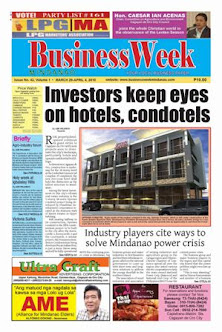Region 10: Mindanao's dominant regional economy
By RUEL V. PELONE, Online Editor
NORTHERN Mindanao is now pulling away as the island’s most dominant regional economy following the reintegration of Iligan City and Lanao del Norte as part of Region 10.
A quick look at the economic accounts of the island’s Gross Regional Domestic Product (GRDP) shows that before the realignment of regions in 2002, Region 10 trailed the Davao Region (Region 11) in GRDP. However, since Iligan and Lanao del Norte rejoined Region 10 in 2002 and some parts of the Davao region were re-aligned to the SOCCSKARGEN region, Davao has trailed Region 10 in current and adjusted GRDP.
The gap between the two region’s GRDPs in current prices wavered from P9.8 billion in 2003, dropping to P7.8 billion in 2005 before accelerating to P25.1 billion by 2008. However, when the differences are adjusted for 1985 constant prices (to negate the effects of inflation on prices), the figures graphically illustrate that the gap between Regions 10 and 11 has been exponentially increasing from P2.3 billion in 2003 to P4.9 billion in 2006 and further to P7.2 billion in 2008.
An analysis of the economic accounts of both regions reveal similarities as well as contrasts.
Although the regional capitals of both regions account for the bulk of the region’s GRDP, there are significant differences in the way the two economies are structured. The bulk of Davao Region’s GRDP comes from the Service Sector based in Davao City and agriculture based both in the city and its surrounding provinces.
Champions of Region 10 in the private and public sectors have often cited the resiliency of the regional economy made possible by this sectoral profile. Because of the even distribution of its GRDP among three sectors, the regional economy has managed to maintain a steady growth rate despite fluctuations in the national and global economy.
This distribution and diversity carries over to the geographical spread of the various sectors. Region 10’s agriculture is concentrated in Bukidnon (pineapple, sugar cane, banana, corn) and Lanao del Norte (rice, coconut) while its industries are mainly found in Misamis Oriental (Phividec Industrial Estate) and Iligan City.
Services which consist mainly of trade (shopping malls), finance (banks), dwellings and real estate (subdivision and commercial business centers), private (BPOs, hotels, schools) and government services (regional government offices) are found mostly in Cagayan de Oro which remains the region’s administrative and trading capital and center of learning and Camiguin, the region’s top tourism destination.
“This well-defined positioning of the provinces also contributes to the complementation of the economic contribution of the various sectors,” noted Eliza Pabillore, Misamis Oriental provincial director of the Department of Trade and Industry (DTI).
However, the geographical distribution of Region 10’s industrial sectors does not necessarily guarantee its immunity from the effects of external influences which may affect one or more of its industrial sectors. That’s because of the way with which these sectors have become vertically and horizontally integrated over the years, leading to varying degrees of interdependence and autonomy.
For instance, when the National Steel Corporation in Iligan City shut down in November 1999, the service sector in Cagayan de Oro also suffered a downturn as machine shops, transport firms, banks, and other downstream industries serving the giant steel firm were forced to cut down or close shop.
Besides retaining its status as the biggest regional economy in Mindanao, Region 10 attained another milestone when it became the fastest growing economy in the country in 2008, outperforming even the National Capital Region and the Philippine economy as a whole, official estimates released by the NSCB show.
Northern Mindanao also sustained its status as Mindanao’s biggest regional economy, increasing its share of the island’s economy from 27.9 percent in 2007 to 28.3 percent in 2008. It also accounted for the biggest share of the sectoral pies with 30.6 percent of service, 30.3 percent for industry and 24.5 percent for AFF.
























0 comments:
Post a Comment